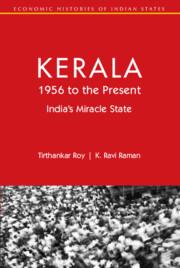Book contents
6 - Growth and Development
Published online by Cambridge University Press: 31 May 2024
Summary
About a decade after India began liberalising its economy, arguments over the best pathway to plan for emerged. Kerala acquired a new significance in this discourse. Did the state have lessons for India at large? The most influential commentators on India's record of human development, Jean Drèze and Amartya Sen, cited the strides in human development, implying that India's policymakers needed to learn lessons from what could be done with limited state resources. A competing view, of which Jagdish Bhagwati was a forceful proponent, said that the accent on human development risked devaluing economic growth. Growth needed competitive markets, which would strengthen the state's finances and sustain the ability to fund welfare and public goods. In this second argument, Kerala was cited as a fiscally unsustainable model. ‘The much-advertised model of alternative development, in the Indian state of Kerala,’ Bhagwati said in a 2004 lecture, ‘with its major emphasis on education and health and only minor attention to growth, had … run into difficulties….’
How sound were these authors in reading the state's history? Not very, one would think. Bhagwati expressed his pessimistic views even as economic growth had begun to surge. His intuition that the model was unsustainable was probably correct but not testable. Drèze and Sen, writing in 2013, did casually acknowledge that economic growth revived and then attributed it to ‘Kerala's focus on elementary education and other basic capabilities’, not going into the details of how these two things were related. Their discussion of the state's recent history almost totally overlooked the most significant force of transformation, a market-driven one: the export of labour. In short, the market-versus-state choices in the 2000s debate were obsolete tools for a historical analysis of the state.
When discussing that history, what should we be looking at? Chronologically, the first major transformation that marked the state out in India was the positive achievements in education and healthcare, which began in the nineteenth century. The second major transition was the declining average fertility and population growth rates in the middle decades of the twentieth century. Since these topics are much discussed, we will be brief and build on a few major works on the subjects.
- Type
- Chapter
- Information
- Kerala, 1956 to the PresentIndia's Miracle State, pp. 99 - 118Publisher: Cambridge University PressPrint publication year: 2024



